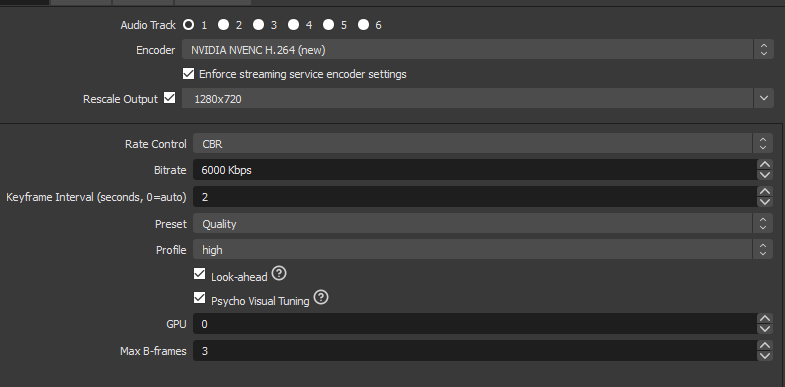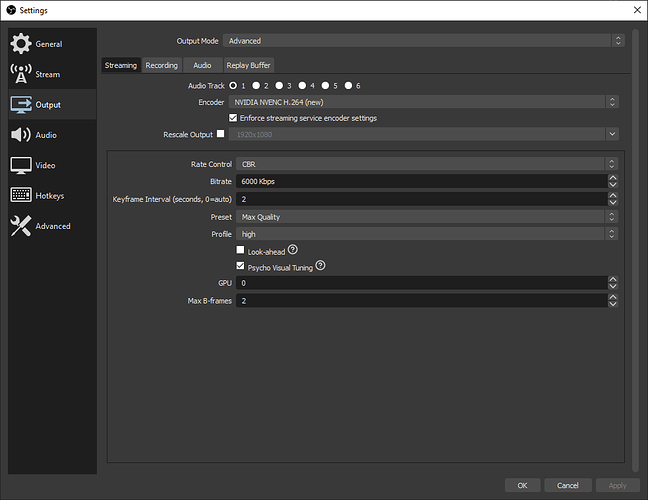Brian Rubin knows how to stream! He is playing some Northgard Co-op tonight!
Moon bases are very poorly lit.
On early, I have time to watch!
I will be there with oreos and milk!
Was streaming some LOTRO the other day and I noticed the ‘stats’ page in OBS showed 23% dropped frames.
Turns out I had to reset the stream encoder settings (as it showed two different NVENCs). I also disabled all the sources I had setup (for various games, but not active). and it dropped to 0% drop.
Image Quality is still terrible thought :-(
Example:
-
https://www.twitch.tv/videos/659455885
Jump to 24m for some of the voiced lore items in the game now, they are pretty nice I think.
I stream at 1080p60 with these settings. I also use this screen for the actual scale:
Here’s a sample of me streaming at these settings:
Cheers.
Damn, that is crystal clear. Wonder why mine looks so grainy/poor. Maybe because I change the output resolution? Will try tweaking a bit and see if it works better today. With NVENC pressumably working now, I should be able to have low performance hit from it. In the past I used the x264 encoder on the cpu running at around 35-40% to get decent IQ, as the NVENC looked terrible at the same bitrate.
when I stopped in earlier I thought it looked good!
Cheers. Had a look at yesterdays recording and it seemed decent enough. Still would like to get a little less artifacts, maybe I can up the bitrate more, but not sure twitch allows above 6k.
Looking at the GPU usage it seemed like there was a lot of ‘breathing room’ there. I’ll try with “high quality” preset. The nvidia guide said it wouldn’t offer much.
Hey sorry I missed all this. First off, have you tried the auto configuration wizard in OBS (Tools -> Auto-Configuration Wizard)? It’s insanely useful as to pointing you to the right directions for which settings to use.
Next, after the next time you stream, create a log (Help -> Log Files -> Upload Current Log) and then paste the URL it gives you into this:
https://obsproject.com/analyzer/
It’ll also help you narrow down any settings that need to be changed.
Don’t stress. It took me hours upon hours of tweaking to get OBS to where I like it.
Seems like the biggest change was ‘reseting’ my settings after I updated to OBS25, as even though I had picked NVENC (new) it somehow had all the wrong settings.
It looks much better now
You can back up your settings once you have it where you want it. I believe it’s File -> Open Settings Folder. You should then close OBS and copy the content of that folder to a backup folder.
Hmm, haven’t really tried the new assassin creeds. Looked decent enough. Guess there is an abundance of ubistuff in them though, which makes it hard to do the storyline since I’m always trying to clear the map first before I do any missions.
It’s surprisingly good, but very long. Very, very long.
Too long, I lost interest in the story mid way through, ended up suffering till I finished it. :P
Here is one of the blogs I just finished yesterday and submitted for work. It isn’t live, yet, and I’m… not sure how it will go over with the higher ups. Hopefully, well. Sorry for the wall of text, but I don’t want to link to my personal Google account just yet:
Being Together
Being Together
The past four months have been tremendous for our species. It may as well have been a chapter from Leo Tolstoy’s War and Peace.
On May 25th, George Floyd was killed by a police officer kneeling on his neck for eight minutes and forty-six seconds; it is tempting to look at this as an isolated incident that sparked a wave of social upheaval. Tragic as the event is, it is only the tip of a very large iceberg. Trayvon Martin, Rodney King, Martin Luther King Jr.: these are household names but they are also among the highest profile individuals to suffer from racism in America. It is one aspect, one symptom of attitudes that go back hundreds of years, and it is expressed in many other ways as well.
It’s easy to look back on these events and wonder “have we changed?”. For all the visibility of MLK’s “I have a dream” speech to King’s “can’t we all just get along?”, it seems as if shockingly little progress has been made when a story like George Floyd’s comes to the fore of consciousness. The worst part of it is these are only the cases everyone remembers. In a June 5th statement on equality Most Reverend Gerald M. Barbarito calls the present crisis “the virus of racism” [1]. To me, it is a virus of racism, because it is expressed in many other ways that are perhaps harder to notice.
A recent study published in the Proceedings of the National Academy of Sciences of the United States of America notes that “a diversity-innovation paradox” exists where “although underrepresented scholars in science-related fields are more likely to innovate, they’re also less likely than their majority-group peers to earn influential academic positions”. The study concludes that “this higher rate of innovation is a result of the unique perspectives and experiences brought by [minority scholars], who ‘often draw relations between ideas and concepts that have been traditionally missed or ignored’” [2]. Although minorities are more likely to innovate within their scientific field due their unique perspective, they are less likely to be promoted to influential positions in that field.
This anti-minority bias is also presented financially; Luca D’Urbino notes in The Economist that “the median household net wealth of African-Americans is $18,000, a tenth of the wealth of white Americans. The ratio has not changed since 1990” [3].
Steven Roberts, a Stanford University psychology professor, outlines in a recent YouTube video seven factors influencing racism in America:
-
Categorization: we tend to group people into categories, and then to think of all members of a given category as being alike.
-
Factions: we are embedded within these categories and tend to treat people belonging to our own category better than those belonging to an out-group.
-
Segregation: groups tend to be separated, whereas having greater diversity provides more opportunities to challenge racism.
-
Hierarchy: dominant groups tend to view themselves as most important, at the top of the ladder, whereas marginalized groups are viewed as ‘less than’. As an example, 98% of U.S. presidents have been white.
-
Power: those at the top of the hierarchy in the U.S. are in a powerful position to transmit beliefs and shape law.
-
Media: tends to present categories in a certain way, often distorted from reality
-
Passivism: in America, the standard response to racism is to do nothing, to be passive. In Roberts’ estimation this is perhaps the biggest contributing factor to the continuation of racism in America.
The five and a half minute video is informative and worth watching [4]. It provides a framework or lens through which to view history.
Thomas Jefferson, founding father and third president of the United States, is often cited as a plantation slave owner. Brent Staples writes that “plantation wives in the slave-era South resorted to willful blindness when their husbands conscripted black women as sexual servants and filled the household with mixed-race children who inevitably resembled the master. Thomas Jefferson’s wife, Martha, was several years dead when he set off on this path, fathering at least six children with Martha’s enslaved black half sister, Sally Hemmings […] slave owners like the Jeffersons often held their own black children, aunts, uncles, and cousins in bondage […] Jefferson’s baronial mountaintop estate was just like any other plantation when it came to matters of sexual conduct” [5].
It is easy to view stories like the one above from a comfortable remove: hundreds of years ago attitudes were different and surely we have moved on as a society. This once was my own viewpoint. Upon further examination, this view is incorrect. History was once current events. The same attitudes resulting in power structures which enabled Thomas Jefferson to own slaves and even to father children who were marginalized and ignored by his own white relatives can be found in the events of recent decades.
Orlando Patterson draws a connection between brutality in law enforcement, mass incarceration, and racism amidst the beginning of the United States. He writes that “America is the only modern nation that had slavery in its midst from the very beginning […] as in the slave system of ancient Athens, the American idea of freedom sprung from the cauldron of slavery in a seemingly contradictory way […] over time, with the expansion of political rights for poor whites, citizenship in the American South came to mean belonging to the ‘superior’ race, which defined blacks as the group that could never belong but whose necessary presence, for essential labor, defined the minimum condition of inclusion […] elements of these early developments persist, especially in the attitudes of police toward minorities and immigrant communities. Those who are thought not to belong are too often viewed as an enemy to be controlled through show of force.” Shifting the lens to the past 50 years, Patterson contends that “closely related to the disproportionate killing of blacks by police is the rise of mass incarceration in America since the early 1970s and the disparate imprisonment of black Americans, who make up about 40% of the nation’s 2.3 million prisoners” and, disturbingly, “imprisonment has typically increased after periods when African-Americans made significant economic, social and political gains” [6].
The factors that Roberts points out are clearly visible in both Jefferson’s plantation estate and in tragic events such as those surrounding George Floyd. There is a horrifying divide between what the U.S. aspires to be, a nation of equals in which the rights of life, liberty, and the pursuit of happiness are honored, and racism throughout its history and foundation. How to become whole?
“Blessed are the meek, for they will inherit the land. Blessed are they who hunger and thirst for righteousness, for they will be satisfied” (Matthew 5:5-6, NAB). So runs the promise of the beatitudes. Simply willing goodness into existence is not enough: clearly, action is necessary. Anything less would be to slip back into the passivity Roberts describes, perpetuating a system that has led to many avoidable deaths. Is it possible to carry the spirit proclaimed during the Sermon on the Mount into action which precipitates positive change?
On March 12, 2019, Latasha Walton, a friend of mine, was shot and killed by a police officer during a traffic stop [7]. She was the mother of two children. At her funeral there was an outpouring of emotion from her sons and her extended family. Present outside were police officers. It was a moment to grieve as a community. There were no solutions given during the speeches, no easy answers. It was very human.
The type of grief this causes lasts for a long time. It’s both personal and collective. Perhaps a tool we have in the fight against racism is to recognize the light in each other. Tara Brach writes “a practice that evolves us (and our larger society) toward inclusive loving is to intentionally deepen our relationships with others of difference” [8]. Also, that “the world is divided into those who think they are right” [9].
Being wrong is freeing. “You will know the truth, and the truth will set you free” (John 8:32, NAB). Coming into alignment with the truth first requires acceptance that one is wrong. In a heartfelt YouTube video, Van Jones notes the incredible response to George Floyd’s killing as a moment of real change [10]. Now more than ever is an opportunity to see beyond differences, past barriers, to honor the humanness of each other, and to interface with those who are different in order to break down viruses of racism. This is not a matter of appropriateness: it is a matter of life or death.
As a white 39 year old male, I am deeply sorry for the generations of trauma my race has inflicted on others. I hope we are able to steer back from racial injustice, from being divided into being right, and that we are able to celebrate the vast array of journeys that are present in our country, regardless of difference.
[1] Barbarito, G. (2020, June 5) Statement on Equality. Diocese of Palm Beach. Retrieved from https://trustedpartner.azureedge.net/docs/library/DioceseofPalmBeach2017/News/Bishops%20Statements/Most%20Reverend%20Gerald%20M_%20Barbarito%20Statement%20on%20Equality.pdf
[2] Howley, K. (2020, June 3) Deep Biases Prevent Diverse Talent From Advancing. Eos. Retrieved from http://eos.org/articles/deep-biases-prevent-diverse-talent-from-advancing?utm_source=eos&utm_medium=email&utm_campaign=EosBuzz060320
[3] D’Urbino, L. (2020, June 11) The power of protest and the legacy of George Floyd. The Economist. Retrieved from https://www.economist.com/leaders/2020/06/11/the-power-of-protest-and-the-legacy-of-george-floyd
[4] Roberts, S. (2020, June 16) What makes a racist? [Video]. YouTube. https://www.youtube.com/watch?v=KWw6huxQ7yQ
[5] Staples, B. (2020, Spring) The Legacy of Monticello’s Black First Family. The University of Chicago Magazine. (Original work published July 4, 2018 in the New York Times).
[6] Patterson, O. (2020, June 6) The Long Reach Of Racism in the U.S. The Wall Street Journal.
[7] Ovalle, D. & Rabin, C. (2019, March 13) Video shows FHP shoot driver during traffic stop in North Miami-Dade. Miami Herald. Retrieved from https://www.miamiherald.com/news/local/crime/article227505289.html
[8] Brach, T. (2019, January 6) Shifting From Blame to Love: 3 Practices for a Wise Heart. Tara Brach. https://www.tarabrach.com/blog-shifting-blame-to-love/
[9] Brach, T. (2020, May 6) Sheltering in Love - Part 7: Awakening from the Prison of Blame. Tara Brach. https://www.tarabrach.com/?powerpress_pinw=10636-podcast
[10] Brach, T. (2020, June 18) Van Jones on racial justice [Video]. YouTube. https://www.youtube.com/watch?v=-oHHRv--8fc
Too tired to watch!


